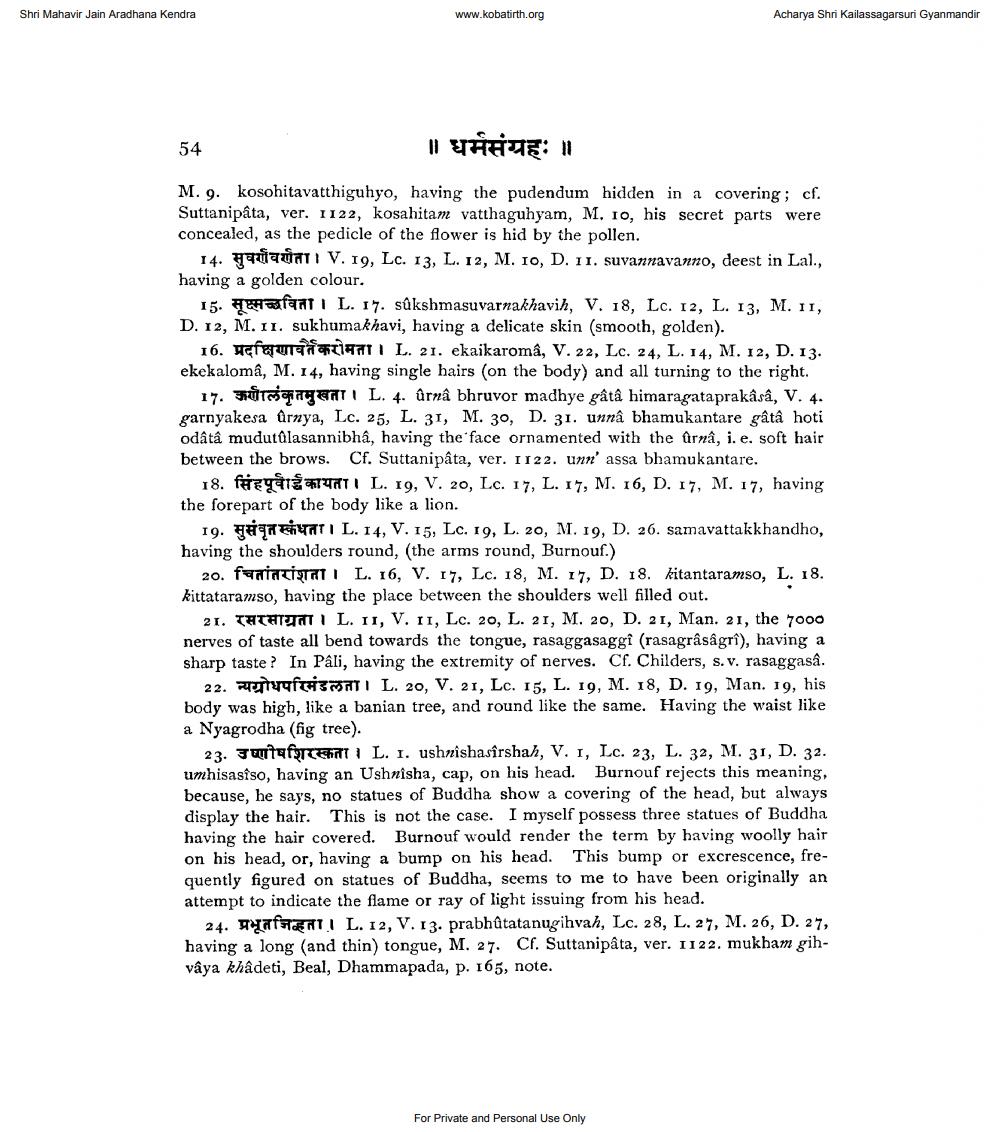________________
Shri Mahavir Jain Aradhana Kendra
www.kobatirth.org
Acharya Shri Kailassagarsuri Gyanmandir
54
II YÄHTE: 1
M. 9. kosohitavatthiguhyo, having the pudendum hidden in a covering; cf. Suttanipata, ver. 1122, kosahitam vatthaguhyam, M. Io, his secret parts were concealed, as the pedicle of the flower is hid by the pollen.
14. TUNTI V. 19, Lc. 13, L. 12, M. 1O, D. II. suvannavanno, deest in Lal., having a golden colour.
15. W ant I L. 17. sukshmasuvarnakhavih, V. 18, Lc. 12, L. 13, M. II, D. 12, M. 11. sukhumakhavi, having a delicate skin smooth, golden). 16. ufaure
L. 21. ekaikaroma, V. 22, Lc. 24, L. 14, M. 12, D. 13. ekekalomâ, M. 14, having single hairs (on the body) and all turning to the right.
17. U T ENTI L. 4. ûrnâ bhruvor madhye gâtâ himaragataprakâsâ, V. 4. garnyakesa úrnya, Lc. 25, L. 31, M. 30, D. 31. unna bhamukantare gâtå hoti odatâ mudutûlasannibha, having the face ornamented with the ûrnâ, i. e. soft hair between the brows. Cf. Suttanipata, ver. 1122. unn' assa bhamukantare.
18. für garaTUATI L. 19, V. 20, Lc. 17, L. 17, M. 16, D. 17, M. 17, having the forepart of the body like a lion.
19. H A YATI L. 14, V. 15, Lc. 19, L. 20, M. 19, D. 26. samavattakkhandho, having the shoulders round, (the arms round, Burnouf.)
20. f atigTAT I L. 16, V. 17, Lc. 18, M. 17, D. 18. kitantaramso, L. 18. kittataramso, having the place between the shoulders well filled out.
21. THTETUTTI L. 11, V. 11, Lc. 20, L. 21, M. 20, D. 21, Man. 21, the 7000 nerves of taste all bend towards the tongue, rasaggasaggi (rasagrâsâgrî), having a sharp taste? In Pali, having the extremity of nerves. Cf. Childers, s.v. rasaggasa.
22. THMATI L. 20, V. 21, Lc. 15, L. 19, M. 18, D. 19, Man. 19, his body was high, like a banian tree, and round like the same. Having the waist like a Nyagrodha (fig tree).
23. Jutare i L. I. ushnishasîrshah, V. 1, Lc. 23, L. 32, M. 31, D. 32. umhisasiso, having an Ushnisha, cap, on his head. Burnouf rejects this meaning, because, he says, no statues of Buddha show a covering of the head, but always display the hair. This is not the case. I myself possess three statues of Buddha having the hair covered. Burnouf would render the term by having woolly hair on his head, or, having a bump on his head. This bump or excrescence, frequently figured on statues of Buddha, seems to me to have been originally an attempt to indicate the flame or ray of light issuing from his head.
24. AHENTI L. 12, V.13. prabhůtatanugihvah, Lc. 28, L. 27, M. 26, D. 27, having a long and thin) tongue, M. 27. Cl. Suttanipata, ver. 1122. mukham gihvậya khẩdeti, Beal, Dhammapada, P. 165, note.
For Private and Personal Use Only




